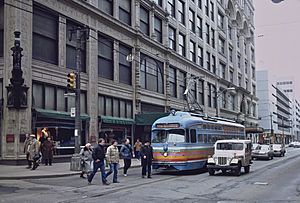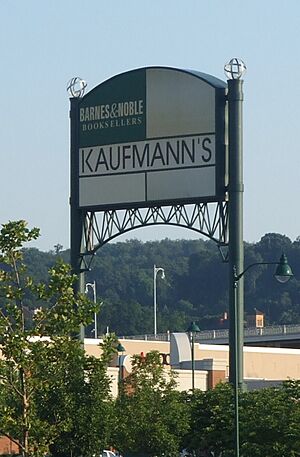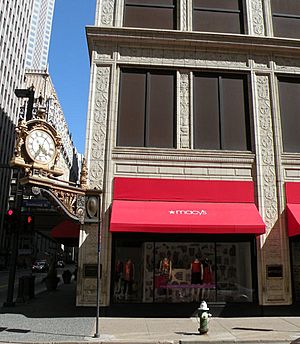Kaufmann's facts for kids
 |
|

Kaufmann's main store in downtown Pittsburgh in 1984, with a trolley car stopping in front
|
|
| Industry | Retail |
|---|---|
| Fate | Acquired by Macy's |
| Successor | Macy's |
| Founded | 1871 |
| Defunct | September 9, 2006 |
| Headquarters | Pittsburgh, Pennsylvania |
|
Key people
|
Jacob Kaufmann, Isaac Kaufmann, and Edgar J. Kaufmann |
| Products | Clothing, footwear, bedding, furniture, jewelry, beauty products, housewares, and auto centers |
| Parent | Federated Department Stores (2005–2006) The May Department Stores Company (1946–2005) |
Kaufmann's was a famous department store that started in Pittsburgh, Pennsylvania. It was a popular place where people could buy many different things, from clothes to furniture. For a long time, it was a big part of shopping in the eastern United States.
Contents
About Kaufmann's Department Store
Kaufmann's was once owned by Edgar J. Kaufmann, who was known for building the famous Fallingwater house. After World War II, Kaufmann's grew into a chain of stores across the eastern United States. It was later owned by Federated Department Stores, which also owns Macy's.
At its biggest, Kaufmann's had about 59 stores in five states. In 2006, the Kaufmann's name was changed to Macy's. This happened because Federated Department Stores bought the company that owned Kaufmann's. In 2015, the main Kaufmann's store in Pittsburgh closed. It was sold to be turned into apartments, restaurants, and a hotel. The new owners named it "Kaufmann's Grand on Fifth" to honor its history.
Kaufmann's History and Growth
Kaufmann's began in Pittsburgh in 1871. It was started by three brothers: Morris, Jacob, and Isaac Kaufmann. They opened a small men's clothing store. In 1877, they moved their store downtown. This new location became known as The Big Store.
Other Pittsburgh Stores
For a while, Kaufmann's was one of seven big department stores in downtown Pittsburgh. Some of these other stores included Horne's, Boggs & Buhl, and Frank & Seder's. Another store, Kaufmann & Baer Co., was started by cousins of the Kaufmann brothers. This store later became Gimbels.
Becoming Part of May Company
In 1946, the Kaufmann's chain was bought by the May Company. Edgar J. Kaufmann stayed on as president. Under the May Company, Kaufmann's had stores in Pennsylvania, New York, Ohio, and West Virginia.
Kaufmann's grew by taking over other department stores. These included Strouss in Ohio, Sibley's in New York, and May Company Ohio. This helped Kaufmann's become a very strong store chain in its region.
Joining Federated Department Stores
In 2002, Kaufmann's main business office in Pittsburgh closed. Its behind-the-scenes work moved to Boston. In 2005, Federated Department Stores bought the May Department Stores Co. for $11 billion. This meant Kaufmann's would soon become part of the Macy's family.
The Famous Kaufmann's Flagship Store
The main Kaufmann's store, called the flagship store, was built in 1887. It was located at 400 Fifth Avenue in downtown Pittsburgh. This building was known as The Big Store. It was expanded and updated many times over the years.
By 1916, a large addition was built. It had a big public clock on the corner. The store eventually grew to 13 floors and covered a whole city block. It was the largest department store in Pittsburgh.
Meet Me Under Kaufmann's Clock
The Big Store had a famous outdoor clock at Fifth Avenue and Smithfield Street. The first clock was put up in 1887. The current clock was installed in 1913. This clock became a symbol of Pittsburgh.
It was a very popular meeting spot downtown. People would often say, "Meet me under Kaufmann's clock." Both the Kaufmann's building and the clock are now Pittsburgh Historical Landmarks.
In 2013, Macy's celebrated the clock's 100th anniversary. They decorated the store windows with photos of the clock. They also held a block party outside the store.
Becoming Macy's
When Macy's bought Kaufmann's in 2006, many people shared their memories of the store. They talked about meeting under the clock and visiting the Tic Toc restaurant. This showed how much Kaufmann's meant to the people of Pittsburgh.
Kaufmann's Parade Tradition
Kaufmann's was the main sponsor of the Celebrate the Season Parade. This parade started in 1980 and went through downtown Pittsburgh. It was held the Saturday after Thanksgiving.
The parade featured big balloons, music, and celebrities. Macy's took over sponsoring the parade after buying Kaufmann's in 2006. In 2014, Macy's stopped being the main sponsor.

Kaufmann's Closure and New Life
The main Kaufmann's store became a Macy's after the company was bought in 2005. Some of Kaufmann's holiday traditions, like the animated Christmas windows and Santa Land, continued at Macy's. Even after the change, some Kaufmann's signs were still visible on the building.
On July 13, 2015, Macy's announced it sold the downtown Pittsburgh building. This meant the store would close after 128 years. The building was sold to a company that planned to turn it into apartments, restaurants, and a hotel. This new project was named "Kaufmann's Grand on Fifth."


